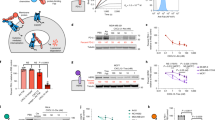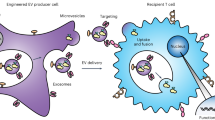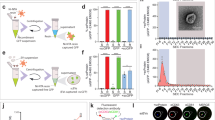Abstract
Prodrug conversion is a promising approach to cytotoxic gene therapy if an efficient transfer of the generated drug to adjacent cells can be achieved. To maximize the efficacy of this strategy we sought to develop a system that is based on a human enzyme, acts extracellularly yet in close vicinity of the transduced cell and can be used with multiple prodrugs. Results obtained with a secreted version of human β-glucuronidase suggested that this enzyme could be a suitable candidate, although a more stringent retention of the enzyme at the site of the producer cell, such as its attachment to the cell surface, would be desirable. Here, we show that the fusion of the transmembrane domain of the human PDGF receptor to a C-terminally truncated form of human β-glucuronidase results in its surface accumulation at high steady-state levels. Using a doxorubicin prodrug, we demonstrate that this GDEPT system produces a strong bystander effect and has potent antitumor activity in vivo.
This is a preview of subscription content, access via your institution
Access options
Subscribe to this journal
Receive 12 print issues and online access
$259.00 per year
only $21.58 per issue
Buy this article
- Purchase on Springer Link
- Instant access to full article PDF
Prices may be subject to local taxes which are calculated during checkout






Similar content being viewed by others
References
Ford JM, Hait WN . Pharmacology of drugs that alter multidrug resistance in cancer Pharmacol Rev 1990 42: 155–199
Springer CJ, Niculescu-Duvaz I . Approaches to gene-directed enzyme prodrug therapy (GDEPT) Adv Exp Med Biol 2000 465: 403–409
Aghi M, Hochberg F, Breakefield XO . Prodrug activation enzymes in cancer gene therapy J Gene Med 2000 2: 148–164
Culver KW et al. In vivo gene transfer with retroviral vector-producer cells for treatment of experimental brain tumors Science 1992 256: 1550–1552
Huber BE et al. In vivo antitumor activity of 5-fluorocytosine on human colorectal carcinoma cells genetically modified to express cytosine deaminase Cancer Res 1993 53: 4619–4626
Mullen CA, Coale MM, Lowe R, Blaese RM . Tumors expressing the cytosine deaminase suicide gene can be eliminated in vivo with 5-fluorocytosine and induce protective immunity to wild type tumor Cancer Res 1994 54: 1503–1506
Bridgewater JA et al. The bystander effect of the nitro-reductase/CB1954 enzyme/prodrug sysem is due to a cell-permeable metabolite Hum Gene Ther 1997 8: 709–717
Marais R et al. A cell surface tethered enzyme improves efficiency in gene-directed enzyme prodrug therapy Nat Biotech 1997 15: 1373–1377
Stribbling SM et al. Regressions of established breast carcinoma xenografts by carboxypeptidase G2 suicide gene therapy and the prodrug CMDA are due to a bystander effect Hum Gene Ther 2000 11: 285–292
Paigen K . Mammalian beta-glucuronidase: genetics, molecular biology, and cell biology Prog Nucleic Acid Res Mol Biol 1989 37: 155–205
Carmeliet P, Jain RK . Angiogenesis in cancer and other diseases Nature 2000 407: 249–257
Rosenfeld MG et al. Biosynthesis of lysosomal hydrolases: their synthesis in bound polysomes and the role of co- and post-translational processing in determining their subcellular distribution J Cell Biol 1982 93: 135–143
Weyel D, Sedlacek HH, Müller R, Brüsselbach S . Secreted human β-glucuronidase: a novel prodrug converting enzyme for gene therapy Gene Therapy 2000 7: 224–231
Kontermann RE, Muller R . Intracellular and cell surface displayed single-chain diabodies J Immunol Meth 1999 226: 179–188
Denzer AJ, Nabholz CE, Spiess M . Transmembrane orientation of signal-anchor proteins is affected by the folding state but not the size of the N-terminal domain EMBO J 1995 14: 6311–6317
Lichtenstein DL, Roberts SR, Wertz GW, Ball LA . Definition and functional analysis of the signal/anchor domain of the human respiratory syncytial virus glycoprotein G J Gen Virol 1996 77: 109–118
Bosslet K, Czech J, Hoffmann D . Tumor-selective prodrug activation by fusion protein-mediated catalysis Cancer Res 1994 54: 2151–2159
Bosslet K, Czech J, Hoffmann D . A novel one-step tumor-selective prodrug activation system Tumor Targetting 1995 1: 45–50
Florent JC et al. Prodrugs of anthracyclines for use in antibody-directed enzyme prodrug therapy J Med Chem 1998 41: 3572–3581
Platel D, Bonoron-Adele S, Dix RK, Robert J . Preclinical evaluation of the cardiac toxicity of HMMR-1826, a novel prodrug of doxorubicin Br J Cancer 1999 81: 24–27
Bosslet K et al. Elucidation of the mechanism enabling tumor selective prodrug monotherapy Cancer Res 1998 58: 1195–1201
Bakinna E, Wu Z, Rosenblum M, Farquhar D . Intensely cytotoxic anthracycline prodrugs: glucuronides J Med Chem 1997 40: 4013–4018
Papot S et al. Synthesis and cytotoxic activity of a glucuronylated prodrug of nornitrogen mustard Bioorg Med Chem Lett 2000 10: 1835–1837
de Bont DB et al. Synthesis and biological activity of beta-glucuronyl carbamate-based prodrugs of paclitaxel as potential candidates for ADEPT Bioorg Med Chem 1997 5: 405–414
Haisma HJ et al. A monoclonal antibody-beta-glucuronidase conjugate as activator of the prodrug epirubicin-glucuronide for specific treatment of cancer Br J Cancer 1992 66: 474–478
Haisma HJ et al. Construction and characterization of a fusion protein of single-chain anti-CD20 antibody and human beta-glucuronidase for antibody-directed enzyme prodrug therapy Blood 1998 92: 184–190
Houba PH et al. Characterization of novel anthracycline prodrugs activated by human beta-glucuronidase for use in antibody-directed enzyme prodrug therapy Biochem Pharmacol 1996 52: 455–463
Leu YL, Roffler SR, Chern JW . Design and synthesis of water-soluble glucuroide derivatives of camptothecin for cancer prodrug monotherapy and antibody-directed enzyme prodrug therapy (ADEPT) J Med Chem 1999 42: 3623–3628
Wang SM et al. Specific activation of glucuronide prodrugs by antibody-targeted enzyme conjugates for cancer therapy Cancer Res 1992 52: 4484–4491
Waxman DJ, Chen L, Hecht JE, Jounaidi Y . Cytochrome P450-based cancer gene therapy: recent advances and future prospects Drug Metab Rev 1999 31: 503–522
Lucibello FC et al. Periodic cdc25C transcription is mediated by a novel cell cycle-regulated represssor element (CDE) EMBO J 1995 14: 132–142
Acknowledgements
We are grateful to Prof HH Sedlacek for prodrug HMR1826 and monoclonal antibodies to β-glucuronidase, to Profs A Wellstein and K Havemann for JEG-3 and A549 cells, respectively, and to Imme Krüger, Tina Stroh, Julia Dick and Claudia Cybon for excellent technical assistance. This work is supported by a grant from the DFG to SB (BR 1857/2).
Author information
Authors and Affiliations
Rights and permissions
About this article
Cite this article
Heine, D., Müller, R. & Brüsselbach, S. Cell surface display of a lysosomal enzyme for extracellular gene-directed enzyme prodrug therapy. Gene Ther 8, 1005–1010 (2001). https://doi.org/10.1038/sj.gt.3301474
Received:
Accepted:
Published:
Issue Date:
DOI: https://doi.org/10.1038/sj.gt.3301474
Keywords
This article is cited by
-
IHEC_RAAC: a online platform for identifying human enzyme classes via reduced amino acid cluster strategy
Amino Acids (2021)
-
Bacterial glucuronidase as general marker for oncolytic virotherapy or other biological therapies
Journal of Translational Medicine (2011)
-
Enhancement of CPT-11 antitumor activity by adenovirus-mediated expression of β–glucuronidase in tumors
Cancer Gene Therapy (2011)
-
Membrane-localized activation of glucuronide prodrugs by β-glucuronidase enzymes
Cancer Gene Therapy (2007)
-
Gene expression imaging by enzymatic catalysis of a fluorescent probe via membrane-anchored β-glucuronidase
Gene Therapy (2007)



